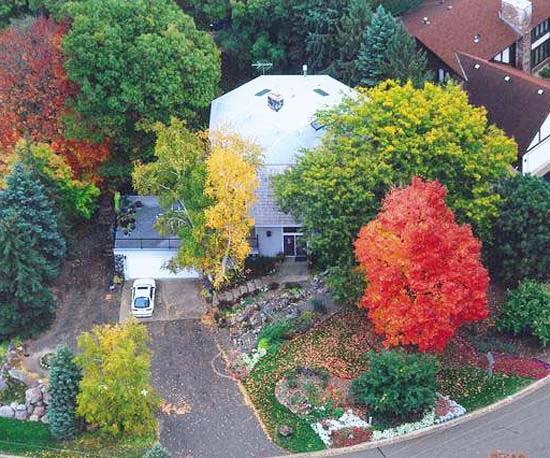15 Tips for Shade-Friendly Perennials from a Minnesota Gardener

Get ideas for making your yard more beautiful with tips from a self-taught shade gardener in Minnesota.
Minnesota Garden Showcases Shade-Friendly Perennials
Gardener Jane Horn has been busy creating a pastoral paradise in her suburban Minnesota garden for the last 12 years. The space lives large, even though her lot is only two-thirds of an acre. Learn how Jane chooses and cares for her shade-friendly perennials in the following slides.
Add Color to Your Side Yard
A wooded hillside provided Jane the perfect backdrop for a rustic flagstone path. Beds of hosta and yellow Corydalis lutea, (one of her favorite plants) flank the charming walkway.
Make Great Plant Combos
Long-blooming Corydalis is a perfect companion for hostas because the foliage creates a wonderful textural contrast. Blue hosta varieties stand out against the yellow Corydalis blooms, while chartreuse selections complement the dainty blossoms.
Test Garden Tip: Contrast wide-leaf hostas with fine-leaf plants such as bleeding heart, astilbe, or Japanese painted fern.
Plant En Masse
Most plants look best when planted in large groups. This is especially true for yellow Corydalis, which offers abundant sprays of tiny flowers over its ferny foliage. Corydalis is a self-seeding perennial that provides a dense groundcover. For a similar look, opt for sweet woodruff, another fine-textured groundcover that's ideal for shade. It has fragrant white flowers that bloom in early May.
Choose Graphic Plants
Jane creates stunning combinations with contrasting foliage colors, like teaming easy-growing coleus with tropical croton, a common houseplant. Lovely purple sweet potato vine and grassy spider plant complete the ensemble. To save money, Jane recommends digging the crotons up each fall and bringing them indoors for the winter.
Create Contrast
Use plants with textural foliage to create harmony in the landscape. One stunning example in Jane's garden is 'White Nancy' lamium and Sedum sieboldii, both of which have silvery leaves. The pair is set off by rich purple angelonia, an annual that blooms profusely all summer long, even in partial shade.
Employ Fun Foliage
Pro garden designers know the importance of focal points to catch your attention and often use a birdbath, fountain, or other type of sculpture. However, you can also employ plants for the same effect! Here, Jane used a swath of burgundy coleus to draw the eye among gold and green foliage.
Pay Attention to Texture
Enjoy a beautiful garden—without a flower in sight—by playing up foliage. Purple Oxalis is a delightful contrast to ferny Corydalis in both color and texture. Jane paired the Oxalis with Japanese painted fern, which has burgundy tones in its fronds. Spotted lungwort ties into the silvery fern fronds, and big-leaf Petasites offers fun contrast with its large leaves.
Decorate with Containers
Several containers dispersed throughout Jane's property provide brilliant splashes of color in her shade garden. This one features 'Trailing Burgundy' coleus, 'China Curl' rex begonia, and the fine texture of artillery plant.
Mix and Match Vessels
A grouping of pots is always a sure design bet. Here, Jane mixes sizes and shapes but kept a blue color theme. A set of globes adds artistic interest.
Grow a Variety of the Same Plant
Jane has a delightful view from her deck thanks to a wonderful collection of colorful hostas. While some gardeners think hostas are boring, you can create brilliant plantings like this by pairing varieties with different leaf colors, sizes, and variegation patterns.
Stop Mowing Slopes
Hostas are a topnotch groundcover for shady areas. Plant them on a tough-to-mow hillside to create a lovely, carefree garden bed. If you have a steep slope that water runs down so quickly the soil can't absorb moisture, try breaking up the hill with rocks or other barriers, which will slow the flow of water.
Use Variegated Varieties
'Patriot' hosta, with its wide white leaf edges, is standout in any planting, but it really shines paired with nonvariegated selections. Jane also mixed in delicate maidenhair fern and Corydalis for texture.
Grow Groundcovers
Add interest to your landscape by using annuals in interesting ways. Here, 'Limon' jewels of opar creates a lovely groundcover. It's a self-seeder, so Jane can let it reappear on its own year after year. Or, because it's an annual, she can mulch over it and plant something else.
Combine Annuals and Perennials
Around the front of her house, Jane uses containers to decorate the base of a pondless waterfall. Purple and burgundy foliage tie the plantings to her backyard and offers plenty of streetside drama.
Add Drama with Purple Foliage
Purple sugarcane, an interesting and uncommon annual, gives this planter of dusty miller, bacopa, and purple 'Magilla' perilla a fireworks effect. If you can't find sugarcane in your area, you can use similar plants like New Zealand flax, lilyturf, and sedge.